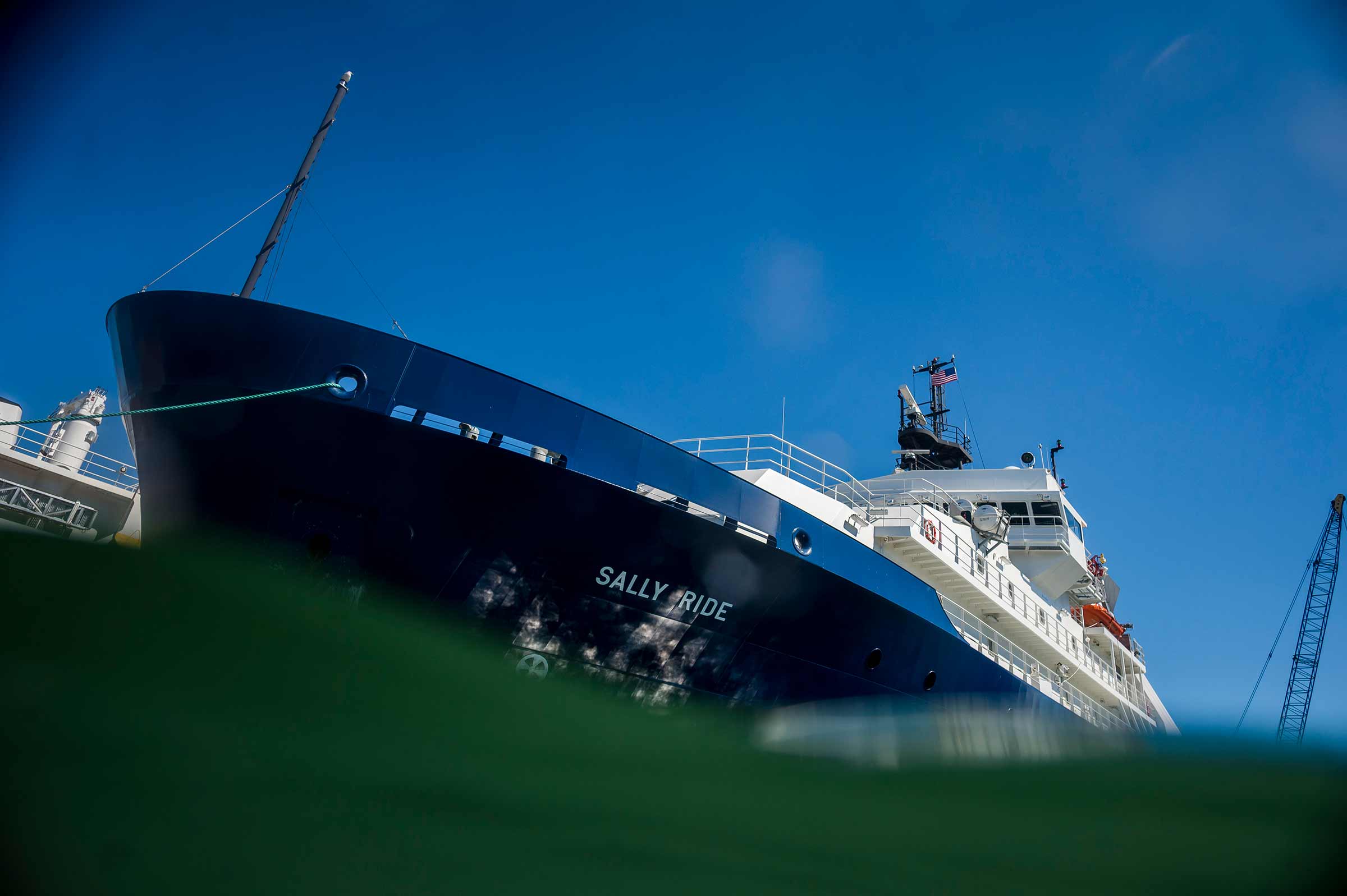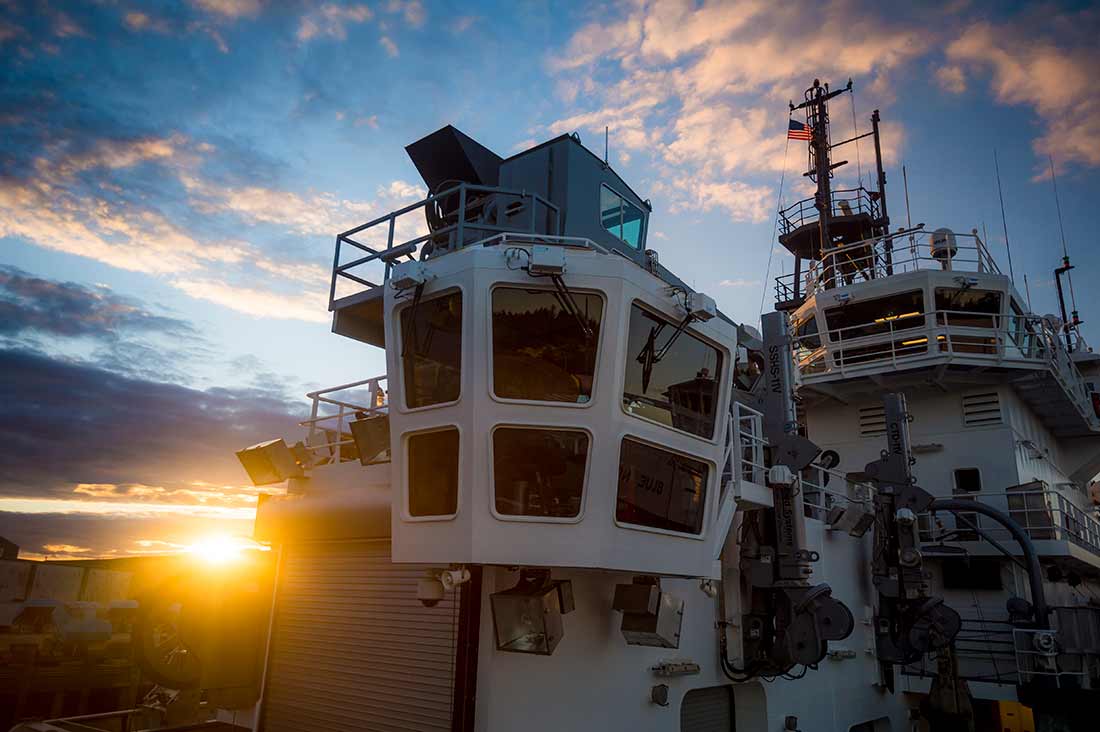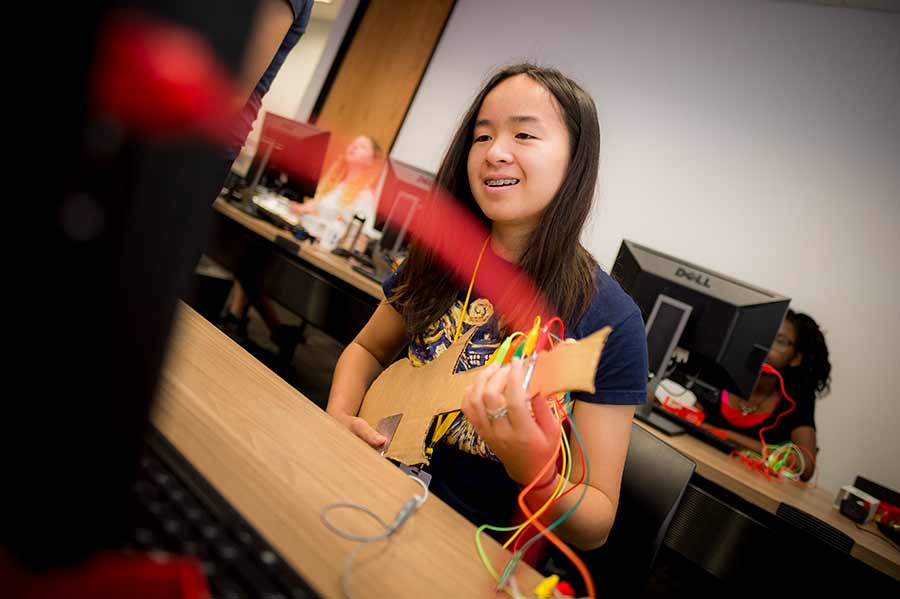
By:
- Rob Monroe
Published Date
By:
- Rob Monroe
Share This:
All Aboard
Join us for a tour of the R/V Sally Ride before her first scientific voyage

Photos by Erik Jepsen/UC San Diego Publications
A new era in American exploration of the oceans will formally begin on Nov. 4 when research vessel Sally Ride begins its career, operated by UC San Diego's Scripps Institution of Oceanography. The UC San Diego community will have a chance to tour the ship on Oct. 29 before it heads out to sea to perform a survey of biological and oceanographic conditions in the California Current.
A nonstop series of events celebrating the arrival of R/V Sally Ride will be held at the Broadway Pier in downtown San Diego over Halloween weekend, beginning with the commissioning of the vessel on Oct. 28 and ending with a public tour opportunity on Oct. 30. Members of the UC San Diego community are invited to come aboard with friends and family between noon and 4 p.m. on Oct. 29.
Besides Broadway Pier activities, the last weekend in October will also host related events at Birch Aquarium at Scripps. The popular attraction will launch Expedition at Sea: R/V Sally Ride Gallery, an immersive exhibit where guests experience the sights and sounds of life and work aboard a research vessel.
The builders of the 238-foot vessel handed R/V Sally Ride over to Scripps in July after five years of design and construction. The ship arrived in San Diego on Aug. 26 after a two-week voyage from its Washington shipyard. It has been undergoing field testing and ongoing installation of equipment on board since then. Just prior to the public events this month, the National Science Foundation will inspect the vessel and and declare its fitness for at-sea research.
An “Ocean Class” vessel with a range of just over 10,000 nautical miles, R/V Sally Ride will explore the Pacific Rim equipped with a technological suite that brings new capabilities to the U.S. research fleet. Besides features such as advanced seafloor-imaging equipment, the vessel will be one of the quietest in the world, enabling scientists to undertake exacting ocean acoustics research. The ship has a dynamic positioning system that allows it to stay at a fixed location to within meters even when winds buffet it at sea.
University officials said they hope R/V Sally Ride would play a role in answering many of the major questions that have been put to the science community in recent decades. On the vessel’s journeys, researchers aim to understand the viability of the world’s ocean food supply, how the oceans are physically and chemically changing as a response to climate change, and what risks Pacific Rim countries and others can expect to face in the future in response to that change.
“As one of the world’s top public research universities, UC San Diego pushes the frontiers of knowledge through exploration and discovery, and advances science for the benefit of humankind,” said Chancellor Pradeep K. Khosla. “Sally Ride will allow us to address our planet’s most pressing challenges and ensure that our oceans and atmosphere are preserved and protected for generations.”

R/V Sally Ride is one of the world’s most technologically advanced ships. Features include dynamic positioning that keeps the ship at a fixed location on the ocean surface to within meters even during high winds. Courtesy Trtion Magazine
As with many of the vessels in the American research fleet, the U.S. Navy owns R/V Sally Ride. Scripps is its operator as a member of the University-National Oceanographic Laboratory System (UNOLS), which makes 19 such ships available for use by scientists across the country. Scripps ships also serve as “living laboratories” that allow Scripps scientists to train the next generation of scientists. Through programs such as UC Ship Funds, Scripps students will gain valuable research opportunities at sea aboard R/V Sally Ride and the rest of the Scripps fleet.
“R/V Sally Ride is an Ocean Class Research Vessel, the product of a thoughtful community-based planning process begun back in 2002, facilitated by the UNOLS Fleet Improvement Committee (FIC) and guided by UNOLS Science Mission Requirements,” said Scripps Associate Director Bruce Appelgate, the head of the institution’s ship operations. “As conceived and built, Sally Ride provides remarkable capabilities to the oceanographic community, and the flexibility to accommodate the evolving needs of scientists for decades to come.”
R/V Sally Ride is the latest manifestation of the long history of collaboration that brings together Scripps’ science mission and the vision of the U.S. Navy and Office of Naval Research in building the academic research fleet.

Crane operator’s perch aboard R/V Sally Ride
The relationship dates back to the years immediately preceding World War II when Scripps first used Navy vessels for research. Throughout the decades, Scripps acquired former Navy vessels for its own fleet and pursued oceanographic, geophysical, and biological research in service to military needs. Today, the Department of Defense provides 20 percent of Scripps’ research budget and much of the technology aboard R/V Sally Ride was furnished through DOD grants.
The Oct. 28 commissioning ceremony itself is a nod to that relationship; the event is not strictly required as it is for Navy vessels but is intended as an affirmation of Scripps’ history with the Navy. Among those in attendance will be Oceanographer of the Navy Rear Adm. Timothy Gallaudet.
"The Navy has enjoyed a close relationship with Scripps for over seven decades. Over that time, Scripps' scientists, engineers, and support personnel have provided our Navy a superior understanding of the ocean, which continues to be critical to maintaining our Navy's maritime superiority,” said Gallaudet, who received his doctorate from Scripps in 2001. "Cutting-edge technologies on R/V Sally Ride will allow Scripps to continue to conduct world-class ocean science at sea and train the next generation of oceanographers. The research done on the Sally Ride will be essential to better understanding our changing oceans and climate, which the Navy needs to know and predict in order to safety and effectively operate around the globe."
The vessel honors one of the most inspirational scientists in American history. Blasting aboard Space Shuttle Challenger in 1983 to become the first American woman—and at age 32, the youngest American in space—the late Sally Ride captured the nation’s imagination by breaking barriers. She joined the faculty at UC San Diego in 1989 as professor of physics and director of the California Space Institute. In 2012, Ride died of pancreatic cancer.

Sally Ride Science will expand UC San Diego's reach to build the STEAM pipeline.
Ride’s legacy lives on, however, through the organizationSally Ride Science, a science education company she co-founded in 2001 that is now based at UC San Diego Extension. Sally Ride Science at UC San Diego provides resources for teacher professional development and opportunities for science education for students. Future generations—especially girls and historically underrepresented K-12 students—will be motivated to continue with STEM in school and beyond through Sally Ride Science at UC San Diego, said university officials.
Scripps Director Margaret Leinen was among many female researchers coming into the workforce as Ride was preparing for her mission in space. Leinen has often recalled how not just the mission in space, but how Ride pursued her career and her life, served as inspiration to her, especially as a young scientist when the academic landscape of the 1970s was very much male-dominated. She had never even met a female Ph.D. in science until her senior year of college.
As a young faculty member in the early 1980s, she and her female students would get together to pop champagne to celebrate their achievements, labeling the corks to memorialize the occasion. They popped a cork on June 18, 1983, when Ride blasted off into space aboard the Space Shuttle Challenger. On the cork, they wrote “Sally Ride represents us all,” recounted Leinen.
“Every female scientist I know knows where they were when Sally Ride went into space. She broke the ultimate glass ceiling,” Leinen said. “A little piece of her spirit, her inspiration, is in this ship and from now on, I’ll always think of that when I hear about its voyages or see it in action.”
Share This:
You May Also Like
Stay in the Know
Keep up with all the latest from UC San Diego. Subscribe to the newsletter today.


